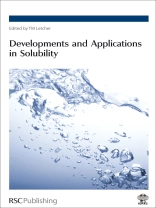Solubility is fundamental to most areas of chemistry and is one of the most basic of thermodynamic properties. It underlies most industrial processes. Bringing together the latest developments and ideas, Developments and Applications in Solubility covers many varied and disparate topics. The book is a collection of work from leading experts in their fields and covers the theory of solubility, modelling and simulation, industrial applications and new data and recent developments relating to solubility. Of particular interest are sections on: experimental, calculated and predicted solubilities; solubility phenomena in ‘green’ quaternary mixtures involving ionic liquids; molecular simulation approaches to solubility; solubility impurities in cryogenic liquids and carbon dioxide in chemical processes. The book is a definitive and comprehensive reference to what is new in solubility and is ideal for researcher scientists, industrialists and academics
Tabla de materias
Part One: THEORY, TECHNIQUES AND RESULTS;
Chapter 1: Thermodynamics of Nonelectrolyte Solubility;
1: Introduction;
2: Thermodynamics;
3: Subtleties of Approximation;
4: Concluding Remarks;
Chapter 2: Thermodynamics of Electrolyte Solubility;
1: Introduction;
2: The Solubility Product;
3: Ion Pairing;
4: Complexation;
5: Electrolye Activities;
6: Pitzer Theory;
7: Treatment of Non-Aqueous or Mixed Aqueous Solvents;
Chapter 3: Experimental, Calculated and Predicted Solubilities – Basis for the Synthesis and Design of Thermal Separation Processes;
1: Introduction;
2: Thermodynamic Fundamentals;
3: Available Solubility Data;
Software Package (DDBSP);
4: Conclusion;
Chapter 4: Solubility of Gases in Ionic Liquids, Aqueous Solutions and Mixed Solvents;
1: Introduction;
2: Fundamentals;
3: Experimental Arrangements;
Apparatus for measuring the solubility of a single gas in a solvent at elevated pressures;
Apparatus for measuring the simultaneous solubility of ammonia and a sour gas in a solvent at elevated pressures;
Apparatus for measuring the solubility of a sour gas in aqueous solutions of amines at low pressures;
4: Experimental Results and Comparison with Predictions/Correlations;
Gas solubility in ionic liquids;
Gas solubility in aqueous solutions of strong electrolytes;
Solubility of ammonia and sour gases in water and aqueous solutions of strong electrolytes;
Solubility of sour gases in aqueous solutions of amines;
Gas solubility in mixed solvents (water + organic compounds);
Gas solubility in mixed solvents (water + organic compound + strong electrolyte);
Chapter 5: SOLUBILITY PHENOMENA IN ‘GREEN’ QUATERNARY MIXTURES (Ionic Liquid + Water + Alcohol + CO2);
1: Introduction;
2: Liquid-Liquid Equilibria: Co-solvent effects in Ternary Mixtures;
3: Liquid-Liquid-Vapour Equilibria: The CO2 anti-solvent effect.;
4: Quaternary systems IL + water + alcohol + CO2;
Cascade of phase changes as switching devices for integrated reaction + separation;
Chapter 6: The Solubility of Gases in Water and Seawater;
1: Introduction;
2: Quantities Used as a Measure of Gas Solubility;
3: Oxygen Solubility in Water;
4: Two Related Experiments that Complement Gas Solubility Data;
5: Treatment of Data;
6: The Solubility of Gases in Water;
7: Annotated Bibliography of the Solubility of Gases in Water;
8: Annotated Bibliography of the Solubility of Gases in Seawater;
9: Summary;
Chapter 7: Isotope Effects on Solubility;
1: Introduction;
2: Theoretical Background;
3: Liquid-Liquid Equilibria;
3.1: Small Molecule Solutions Including Aqueous Systems;
3.2: Polymer Systems and Polymer Solutions;
4: Solubility of Gases in Liquids;
5: Solubility of Ionic Solids in H2O/D2O;
Chapter 8: Solubility of Organic Solids for Industry;
1: Introduction;
2: Solubility in Binary Systems;
1.1: Solid-Liquid Equilibria in Binary Systems;
1.2: Liquid-Liquid Equilibria in Binary Systems;
3: Solubility in Ternary Systems;
3.1: Solubility of Solids in Binary Solvent Mixtures;
3.2: Solubility of Mixtures of Two Solids in a Solvent;
3.3: Liquid-Liquid Equilibria in Ternary Systems;
4: Correlation Methods;
5: Prediction Methods;
6: High Pressure Solid-Liquid Equilibria;
7: Polymers Solubility;
8: Ionic Liquids Solubility;
Chapter 9: CO2 Solubility in Alkylimidazolium-Based Ionic Liquids;
1: Introduction;
Symbolism;
2: Phase Behaviour;
3: Molecular Interactions;
4: Effect of Anion;
5: Effect of Cation Alkyl Chain Length;
6: Substitution in C2 Position;
7: Effects of Impurities;
8: Conclusions and Summary;
Part Two: MODELLING AND SIMULATION;
Chapter 10: Solubility and Molecular Modelling;
1: Introduction;
2: Thermodynamics of Solution;
3: Modelling Solubility;
Molecular Force Fields;
Free Energy Routes;
4: Solute-Solvent Interactions in Ionic Liquids;
5: Conclusion;
Chapter 11: Molecular Simulation Approaches to Solubility;
1: Introduction;
2: Solubility;
3: Computing Solubility for the Infinite Dilution Limit;
Thermodynamic Integration;
Free Energy Perturbation;
Expanded Ensembles;
Transition Matrix Monte Carlo;
Gibbs Ensemble;
Continuum Solvation Models;
4: Computing the Solubility Limit;
5: Finite Size Effects;
Chapter 12: Prediction of Solubility with COSMO-RS;
1: Introduction;
2: COSMO-RS;
3: Computational Details;
4: Solubility;
5: Salt Solubility;
6: Summary and Conclusions;
Part Three: INDUSTRIAL APPLICATIONS;
Chapter 13: Solubility of impurities in cryogenic liquids;
1: Introduction;
2: Loss of Prevention in Cryogenic Plants;
3: Experimental Methods;
Synthetic-Optical Method;
Evaporation Method;
The static-analytical methods: spectroscopic analysis;
The static-analytical methods: Chromatographic analysis;
4: Review of Literature data;
5: Conclusions;
Chapter 14: Solubility of BTEX and Acid Gases in Alkanolamine Solutions in relation to the Environment;
1: Introduction;
2: Choice of Amine;
3: Experimental Techniques;
4: Experimental Results;
5: Thermodynamics Frameworks;
6: Conclusion;
Chapter 15: Solubility of Solids in Bayer Liquors;
1: Introduction;
2: Pitzer Equation;
3: Comprehensive Pitzer Model for Synthetic Bayer liquors;
4: Model Validation and Solubilities in Multi-component Systems;
5: Conclusion;
Chapter 16: Solubility of Gases in Polymers;
1: Introduction;
2: Experimental Measurements of Gas Solubility;
2.1: Gravimetric Techniques;
2.2: Vibration or Oscillating Techniques;
2.3: PVT-Techniques and the Pressure Decay Method;
2.4: Gas Flow Techniques;
2.5: The Coupled VW-PVT-Technique;
3: Experimental Evaluation of Gas-Polymer Interactions and Thermophysical Properties;
4: Importance of Solubility and Associated Properties for Industrial Applications;
5: Conclusion;
Chapter 17: Solubility in the Hydrometallurgical Leaching Process;
1: Mineral Processing by Aqueous Solutions;
2: Dissolution of Sulphidic Zinc Concentrate and Gas-Liquid Mass Transfer;
3: Oxygen Solubility;
4: Solubilities of Solids in Process Solutions;
5: Concluding Remarks;
Chapter 18: Solubility Related to Reaction and Process Design;
1: Introduction;
2: Educt Purification and Additive Introduction;
Example 1 -Polyurethane Foam Quality;
3: Reaction Design;
Example 2 – Polyether Reaction Design;
Example 3 – Chloroformate Reaction Design;
Example 4 – Formaldahyde Production;
Example 5 – Polyester Reaction Design;
4: Separation Processes;
Example 6 – Furfural Production;
5: Surprising effects of Solubilities;
Example 7 – Polyether Reaction Design;
Example 8 – FID Alarm in Fermentation Reactor;
6: Conclusion;
Chapter 19: Measurements and modelling solid solubilities in supercritical phases: application to a pharmaceutical molecule, eflucimibe;
1: Introduction;
2: Experimental – Equipment and Procedures;
3: Solubility in pure CO2;
4: Ethanol and DMSO co-solvent effects;
5: Modelling;
6: Extension of the Chrastil Model;
7: Generalizing the Mendoz-Santiago-Teja Model;
8: Conclusion;
Chapter 20: Solubility in Food, Pharmaceutical and Cosmetic Industries;
1: Industrial Importance;
2: Water Solubility;
3: Organic and Mixed Solvent Solubility;
4: Liquid-Liquid Solubility;
5: Solubility in Supercritical Fluids;
6: Conclusions;
Chapter 21: Solubility of Solids in Radioactive Waste Repositories;
1: Introduction;
2: The safety concept of a geological repository;
3: Solubility of solids in repository safety assessments;
What is the composition of the solution?;
Which are the relevant thermodynamic data?;
Which are the relevant solid phases?;
Chapter 22: Carbon Dioxide in Chemical Processes;
1: Applications of CO2;
2: Carbon Dioxide in Multiphase Aqueous Systems;
3: Applications in the Process Industries;
4: Dynamic Systems;
5: Concluding Remarks;
Chapter 23: SOLUBILITY AND THE OIL INDUSTRY;
1: Introduction;
2: Theory;
3: Experimental methods;
4: Literature review;
4.1: Gases in liquids;
4.2: Liquids in gases;
4.3: Liquids in liquids;
4.4: Gases in solids;
4.5: Solids in gases;
4.6: Solids in liquids;
4.7: Gases, liquids and solids;
5: New results;
Chapter 24: Solubility of Inorganic Salts and their Industrial Importance;
1: Introduction;
2: Oceanic Salts;
2.1: Production of K2SO4;
2..2: Solution mining of Carnallite;
3: Salts from non-Oceanic Salt Lakes;
4: Salt Phase Formation in Building Materials;
5: Salt Hydrates for Heat Storage












